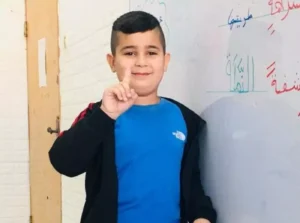‘Feeling threatened’: An Israeli prescription for killing with no criticism or oversight

Adam al-Ghoul, 9, was killed by Israeli forces in Jenin
Amira Hass writes in Haaretz on 25 March 2024:
“I felt threatened” became, long before October 7, an automatic defense whenever a Jew kills a Palestinian. “I felt” is a very personal and subjective state of being, but when spoken in IDF-ese, namely, in contemporary Hebrew, it becomes a rigid and objective truth sheltering all those under its wings.
The identity of the dangerous suspect shot to death usually varies. Defining the suspect as dangerous and fit-to-be-killed does not require them to carry a weapon. Nor does the age or gender matter. However, the person feeling subjectively threatened must meet two conditions so as not to be suspected of lying, and so that public opinion’s yardstick will safeguard his impunity: he has to be Jewish and he has to be armed.
Will the fact that the dead 63-year-old man was a convert well-liked by the settlers change the storyline which automatically absolves settlers who kill?
Last Thursday, the person who objectively felt subjectively threatened, killing a man who looked Arab, was a settler recruited to the “regional defense” battalion on guard duty near the settlement of Elazar, which lies on land belonging to the Palestinian village of Al-Khader. The Devil, ever so sly, gave this incident a particular twist: Sameh Zeitoun, the victim, was not only 63, the age of a grandfather, he was also a resident of Hebron who had converted to Judaism, assuming the name David Ben-Abraham.
According to a report on Ynet, he was imprisoned for this in a Palestinian prison for two months in 2019, suffering torture and abuse. The other prisoners also tormented and beat him, he testified after his release. One of the settler dignitaries in Hebron, Noam Arnon, expressed his sorrow over the tragic death of Zeitoun/Ben-Abraham. According to the Walla website, Arnon also said that Zeitoun/Ben-Abraham always carried a small knife in his bag for self-defense.
A news website called Arabi 21 showed a video clip in which Zeitoun denies that he converted to Judaism. Whether he was forced to do so during his imprisonment or not doesn’t change the fact: the soldiers saw an Arab, and suspected him. The knife they found in his bag confirmed their suspicions, which were immediately turned into an on-the-spot verdict and sentence, carrying the penalty of a mortal wound.
The army expressed its dissatisfaction. “A serious incident,” they called the killing of Zeitoun/Ben-Abraham. The military police’s investigative branch launched an inquiry and the soldier who shot him was interrogated with a warning. However, military defense lawyers are convinced that the shooter will ultimately be given a medal. Will the fact that the victim was a convert whom the settlers knew and respected tilt the story from its usual path of understanding the shooter’s motives and exonerating him from any institutional or social blame, as in many other cases? We don’t know.
The word “serious” is missing in the IDF spokesman’s reference to a lethal incident in which soldiers in a tank shot starving Palestinians crowding around a food convoy on February 29. A hundred of them died, whether from gunfire or while fleeing it, or trampled to death by others. There were at least 12 such cases of Israeli soldiers shooting at food convoys, but the number of fatalities was not so high, which is why they didn’t make headlines in Israel.
Or, it was argued that the killed people were from Hamas (who according to the Palestinians were charged with protecting the trucks from armed gangs). The IDF secured the convoy on February 29, which, at Israel’s request, was funded by Palestinian businessmen. “It’s hard to complain about junior commanders on the ground who were caught in a situation they believed was threatening the lives of their soldiers,” wrote Amos Harel in Haaretz. All the reports of hunger and starvation in the northern Gaza Strip is not enough to overcome the soldiers and commanders’ subjective sense of danger for their lives.
Soldiers in a tank may feel personally threatened by an explosive device attached to their armored vehicle, under the cover of a crowd of starving people surrounding them. The sole cure they know for their subjective fears is direct fire. A drone operator however doesn’t have such concerns. Last Thursday, Al-Jazeera showed a video clip that was hard to watch: It showed four figures openly walking among destroyed and semi-destroyed houses, on a sandy path on which tank treads could be seen.
This was in early February, and the narration notes that the four were walking toward their house or what was left of it. Many Gazans are doing this, whether to see what happened to their home or in order to save something from the ruins: food, possibly some jewelry, or even cigarettes. However, in this case, three missiles killed them. The IDF spokesman told Haaretz correspondent Jackie Khoury that “this an active war zone in the Khan Yunis area, where forces have had many encounters with terrorists who fight and move around in civilian clothing.”
In other words, the drone operator acted on behalf of a collective sense of threat felt by other soldiers. It was not a light finger on the trigger, implies the IDF spokesman, but experience and professionalism. Trust us. Even so, Khoury was told, the General Staff’s investigative apparatus was examining the video. A hypothesis: only because it reached Al-Jazeera. We will never know how many thousands of Palestinian civilians were killed in the same manner, according to the same automatic subjective recipe for killing. We will never know the identity and number of pilots and drone operators who killed Palestinian civilians, ostensibly due to a collective concern (also serving as a masquerade for revenge), protected in advance from any oversight, criticism, correction, self-examination and sleepless nights.
This article is reproduced in its entirety
